engine DODGE SPRINTER 2004 1.G User Guide
[x] Cancel search | Manufacturer: DODGE, Model Year: 2004, Model line: SPRINTER, Model: DODGE SPRINTER 2004 1.GPages: 272, PDF Size: 22.71 MB
Page 20 of 272

20 THINGS TO KNOW BEFORE STARTING YOUR VEH ICLEThe alarm is triggered if the security system has been
activated and
A door is opened,
a door is unlocked from inside,
the engine cover is opened,
the key is used to unlock the vehicle at any door,
the key is turned to position 2 in the ignition lock.Audible AlarmThe horn sounds for about 25 seconds.Visual A larmThe turn signal lamps flash for about 4 minutes.Switching off the A larmThe alarm will switch off immediately if the vehicle is
unlocked using the remote keyless entry transmitter.
NOTE: Do not manually unlock the doors as this will
trigger the alarm.
TOWING PROTECTION AND PASSENGER
COMPARTMENT PROTECTION SWITCH
(OPTIONA L)See Section 4, Understanding Your Instrument Panel,
for switch locations.
Switch off the towing protection
Indicator lamp
As a function check, (1) the indicator
lamp (2) flashes when the security
system is switched on.
Switch off the passenger compartment protection.Towing ProtectionThe towing protection is ready for operation after
30 seconds as the security system has been activated.
The alarm is triggered if the vehicle is lifted while the
security system is activated.Switching off the Towing ProtectionIf the vehicle is to be transported or loaded, the towing
protection must be switched off in order to avoid a
false alarm.
Freightliner-all.book Pag e 20 Monday , December 1, 2003 2:54 PM
Page 25 of 272
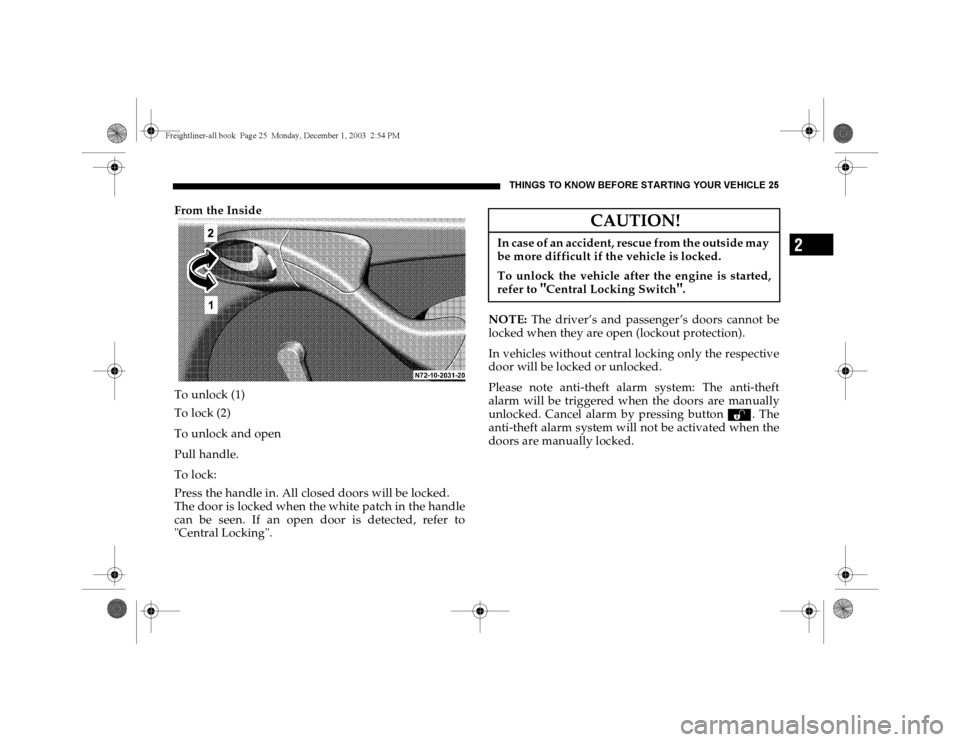
THINGS TO KNOW BEFORE STARTING YOUR VEHICLE 25
2
From the Inside
To unlock (1)
To lock (2)
To unlock and open
Pull handle.
To lock:
Press the handle in. All closed doors will be locked.
The door is locked when the white patch in the handle
can be seen. If an open door is detected, refer to
"Central Locking".NOTE: The driver’s and passenger’s doors cannot be
locked when they are open (lockout protection).
In vehicles without central locking only the respective
door will be locked or unlocked.
Please note anti-theft alarm system: The anti-theft
alarm will be triggered when the doors are manually
unlocked. Cancel alarm by pressing buttonŒ. The
anti-theft alarm system will not be activated when the
doors are manually locked.
CAUTION!
In case of an accident, rescue from the outside may
be more difficult if the vehicle is locked.
To unlock the vehicle after the engine is started,
refer to
"Central Locking Switch
".
Freightliner-all.book Pag e 25 Monday , December 1, 2003 2:54 PM
Page 28 of 272
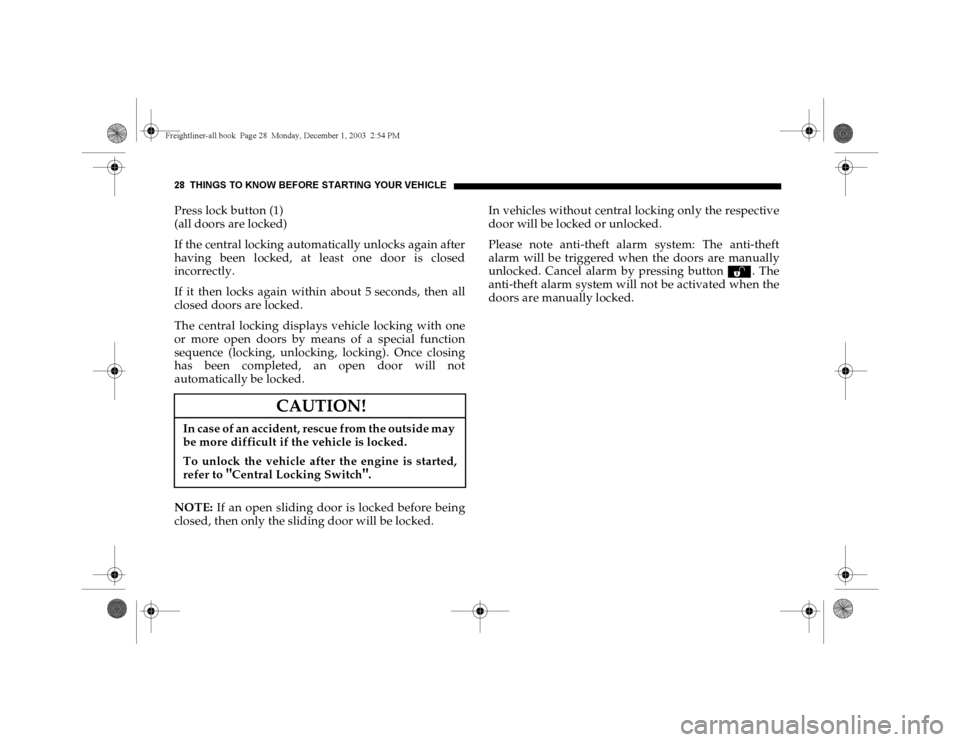
28 THINGS TO KNOW BEFORE STARTING YOUR VEH ICLEPress lock button (1)
(all doors are locked)
If the central locking automatically unlocks again after
having been locked, at least one door is closed
incorrectly.
If it then locks again within about 5 seconds, then all
closed doors are locked.
The central locking displays vehicle locking with one
or more open doors by means of a special function
sequence (locking, unlocking, locking). Once closing
has been completed, an open door will not
automatically be locked.
NOTE: If an open sliding door is locked before being
closed, then only the sliding door will be locked.In vehicles without central locking only the respective
door will be locked or unlocked.
Please note anti-theft alarm system: The anti-theft
alarm will be triggered when the doors are manually
unlocked. Cancel alarm by pressing buttonŒ. The
anti-theft alarm system will not be activated when the
doors are manually locked.
CAUTION!
In case of an accident, rescue from the outside may
be more difficult if the vehicle is locked.
To unlock the vehicle after the engine is started,
refer to
"Central Locking Switch
".
Freightliner-all.book Pag e 28 Monday , December 1, 2003 2:54 PM
Page 46 of 272
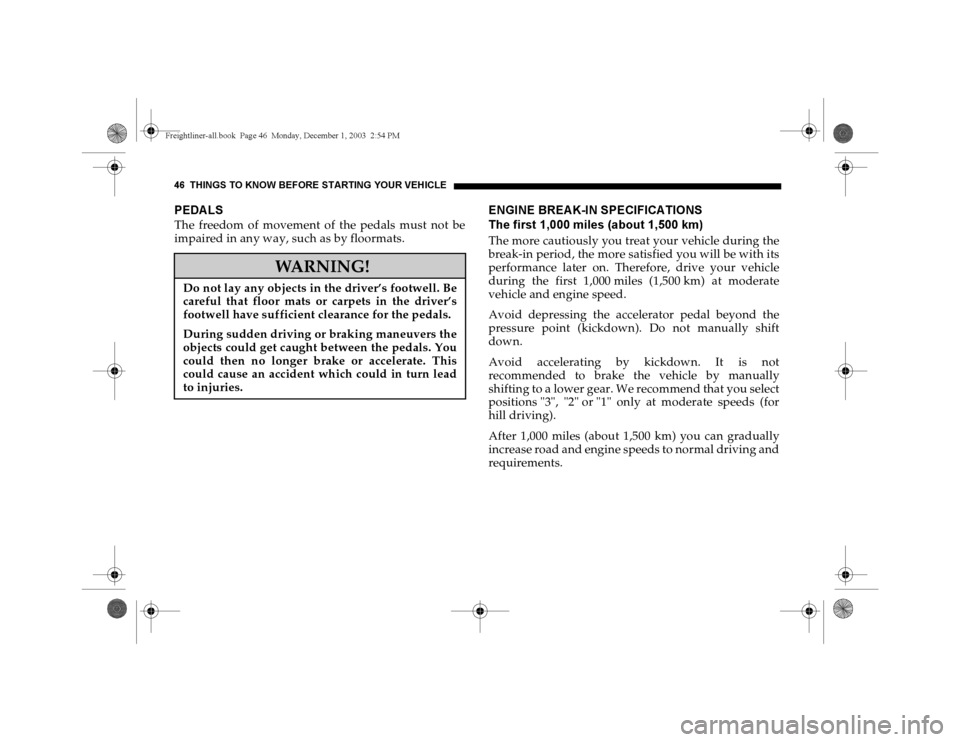
46 THINGS TO KNOW BEFORE STARTING YOUR VEH ICLEPEDALSThe freedom of movement of the pedals must not be
impaired in any way, such as by floormats.
ENGINE BREAK-IN SPECIFICATIONS
The first 1,000 miles (about 1,500 km)The more cautiously you treat your vehicle during the
break-in period, the more satisfied you will be with its
performance later on. Therefore, drive your vehicle
during the first 1,000 miles (1,500 km) at moderate
vehicle and engine speed.
Avoid depressing the accelerator pedal beyond the
pressure point (kickdown). Do not manually shift
down.
Avoid accelerating by kickdown. It is not
recommended to brake the vehicle by manually
shifting to a lower gear. We recommend that you select
positions "3", "2" or "1" only at moderate speeds (for
hill driving).
After 1,000 miles (about 1,500 km) you can gradually
increase road and engine speeds to normal driving and
requirements.
WARNING!
Do not lay any objects in the driver’s footwell. Be
careful that floor mats or carpets in the driver’s
footwell have sufficient clearance for the pedals.
During sudden driving or braking maneuvers the
objects could get caught between the pedals. You
could then no longer brake or accelerate. This
could cause an accident which could in turn lead
to injuries.
Freightliner-all.book Pag e 46 Monday , December 1, 2003 2:54 PM
Page 47 of 272

THINGS TO KNOW BEFORE STARTING YOUR VEHICLE 47
2
Engine Oil ConsumptionWhen the engine has passed the break-in period, oil
consumption may reach 0.5 % of the fuel consumption
recorded in actual operating circumstances. In isolated
cases and in arduous operating conditions, oil
consumption may increase to 1 % of the fuel
consumption recorded in actual operating
circumstances.
Engine oil consumption depends on the driving style
adopted and the operating conditions. It can only be
judged after the engine has passed the break-in period.
For engine oil level.SA FETY TI PS Check the vehicle’s lights and the general condition
of the vehicle before each trip.
Keep tires at the recommended inflation pressure.
All occupants should fasten their seat belts before
each trip.
Driving in an environmentally responsible manner
will reduce noise, fuel consumption and exhaust
emissions. Allow the engine to warm up under low load use.
Avoid unnecessarily hard acceleration, driving with
the throttle fully open, and carrying loads not
specifically needed on the journey.
Stop the engine during lengthy waiting periods, for
example at traffic lights.
Remove ancillary parts, such as wind deflectors and
roof racks, as soon as they are no longer needed.Freightliner-all.book Pag e 47 Monday , December 1, 2003 2:54 PM
Page 48 of 272
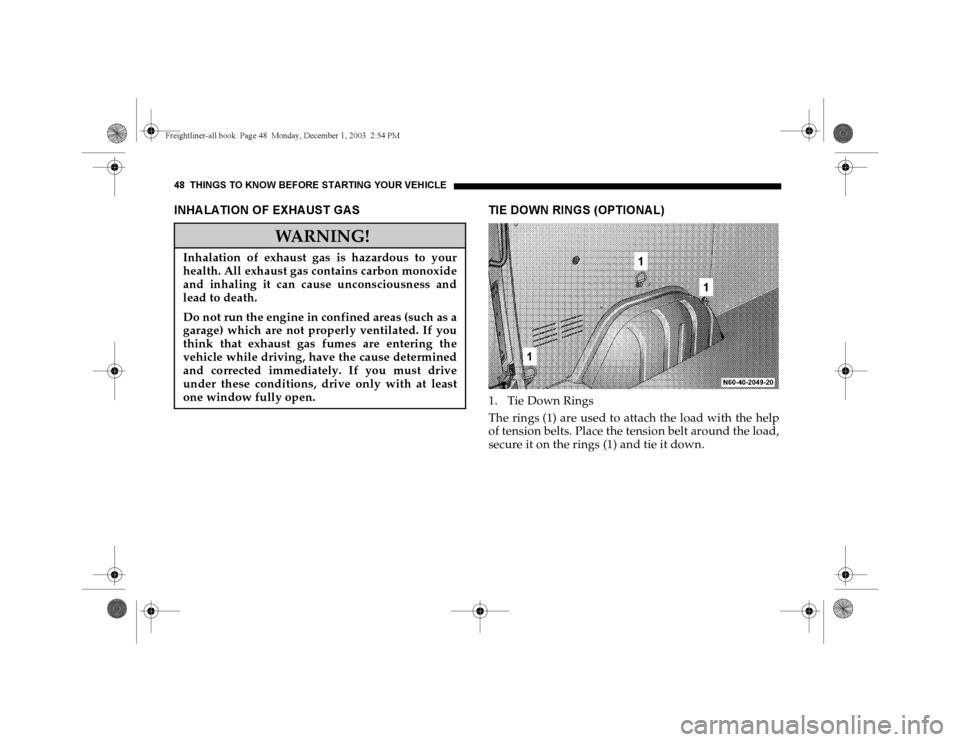
48 THINGS TO KNOW BEFORE STARTING YOUR VEH ICLEINHA LA TION OF EXHA UST GA S TIE DOWN RINGS (OPTIONA L)
1. Tie Down Rings
The rings (1) are used to attach the load with the help
of tension belts. Place the tension belt around the load,
secure it on the rings (1) and tie it down.
WARNING!
Inhalation of exhaust gas is hazardous to your
health. All exhaust gas contains carbon monoxide
and inhaling it can cause unconsciousness and
lead to death.
Do not run the engine in confined areas (such as a
garage) which are not properly ventilated. If you
think that exhaust gas fumes are entering the
vehicle while driving, have the cause determined
and corrected immediately. If you must drive
under these conditions, drive only with at least
one window fully open.
Freightliner-all.book Pag e 48 Monday , December 1, 2003 2:54 PM
Page 60 of 272
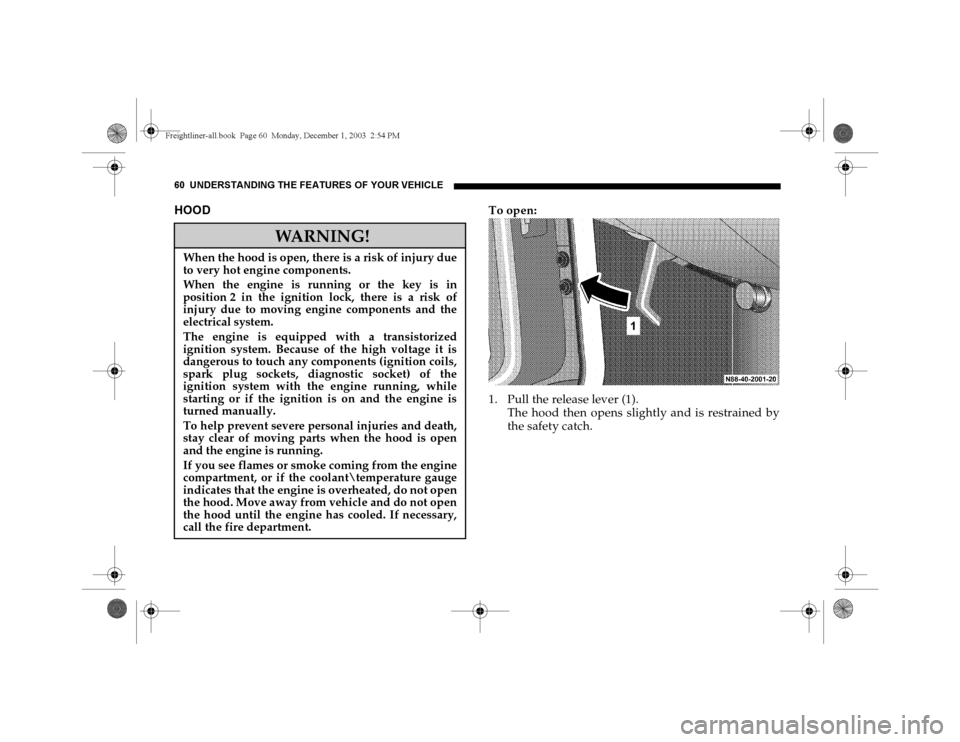
60 UNDERSTANDING THE FEATURES OF YOUR VEHICLEHOOD
To open:
1. Pull the release lever (1).
The hood then opens slightly and is restrained by
the safety catch.
WARNING!
When the hood is open, there is a risk of injury due
to very hot engine components.
When the engine is running or the key is in
position 2 in the ignition lock, there is a risk of
injury due to moving engine components and the
electrical system.
The engine is equipped with a transistorized
ignition system. Because of the high voltage it is
dangerous to touch any components (ignition coils,
spark plug sockets, diagnostic socket) of the
ignition system with the engine running, while
starting or if the ignition is on and the engine is
turned manually.
To help prevent severe personal injuries and death,
stay clear of moving parts when the hood is open
and the engine is running.
If you see flames or smoke coming from the engine
compartment, or if the coolant\temperature gauge
indicates that the engine is overheated, do not open
the hood. Move away from vehicle and do not open
the hood until the engine has cooled. If necessary,
call the fire department.
Freightliner-all.book Pag e 60 Monday , December 1, 2003 2:54 PM
Page 77 of 272
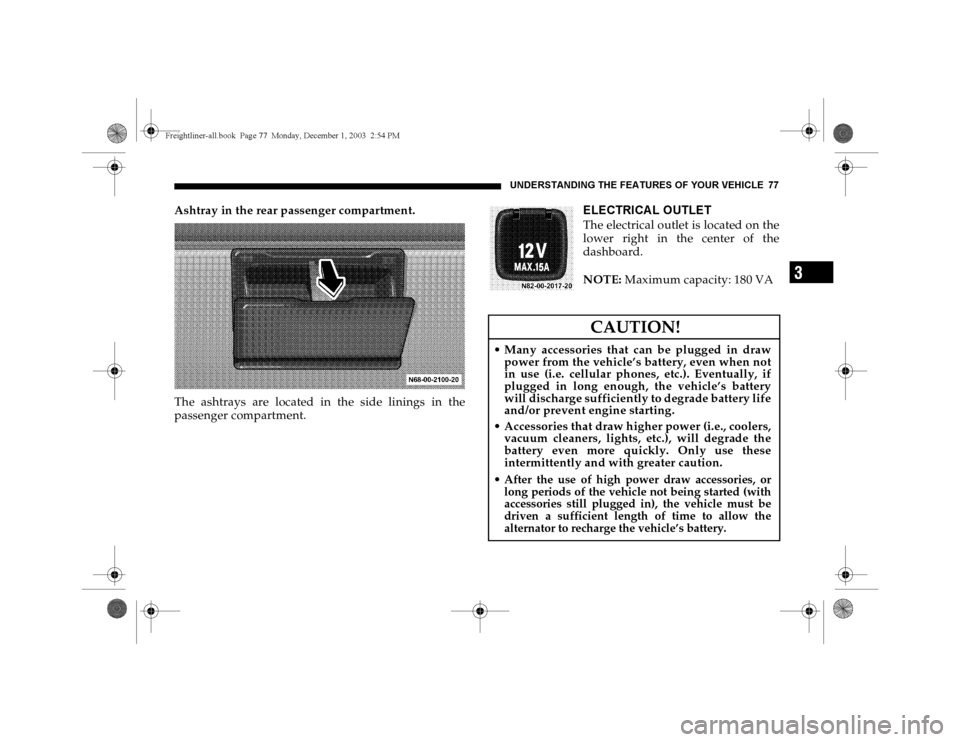
UNDERSTANDING THE FEATURES OF YOUR VEHICLE 77
3
Ashtray in the rear passenger compartment.
The ashtrays are located in the side linings in the
passenger compartment.
ELECTRICAL OUTLETThe electrical outlet is located on the
lower right in the center of the
dashboard.
NOTE: Maximum capacity: 180 VACAUTION!
Many accessories that can be plugged in draw
power from the vehicle’s battery, even when not
in use (i.e. cellular phones, etc.). Eventually, if
plugged in long enough, the vehicle’s battery
will discharge sufficiently to degrade battery life
and/or prevent engine starting.
Accessories that draw higher power (i.e., coolers,
vacuum cleaners, lights, etc.), will degrade the
battery even more quickly. Only use these
intermittently and with greater caution. After the use of high power draw accessories, or
long periods of the vehicle not being started (with
accessories still plugged in), the vehicle must be
driven a sufficient length of time to allow the
alternator to recharge the vehicle’s battery.
Freightliner-all.book Pag e 77 Monday , December 1, 2003 2:54 PM
Page 81 of 272
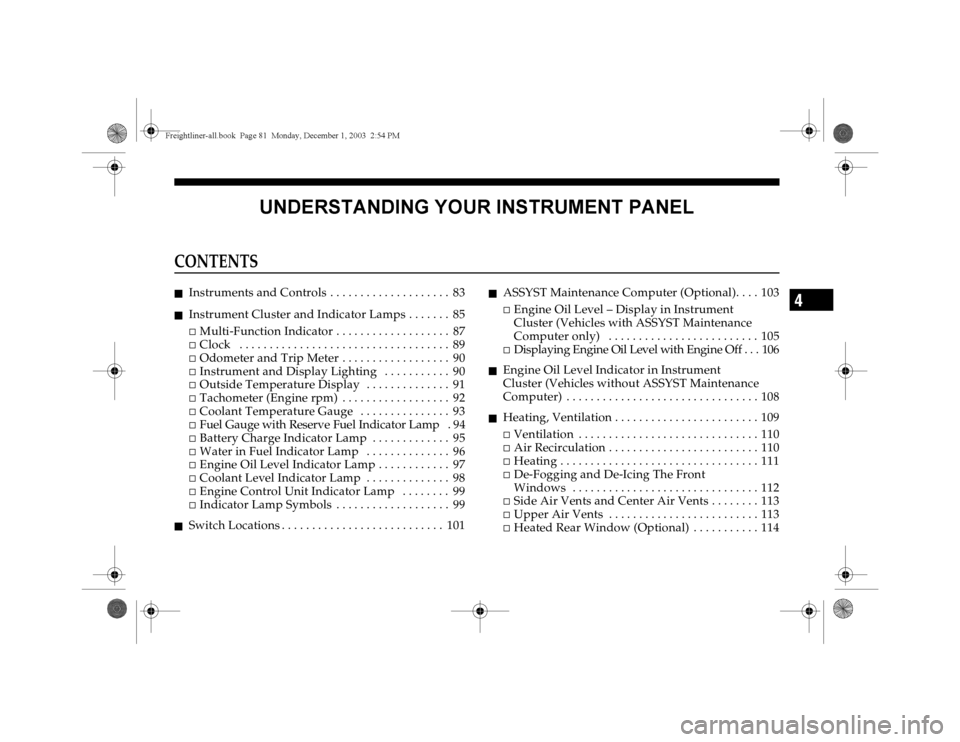
UNDERSTANDING YOUR INSTRUMENT PANEL
4
CONTENTS�
Instruments and Controls . . . . . . . . . . . . . . . . . . . . 83
�
Instrument Cluster and Indicator Lamps . . . . . . . 85�Multi-Function Indicator . . . . . . . . . . . . . . . . . . . 87�Clock . . . . . . . . . . . . . . . . . . . . . . . . . . . . . . . . . . . 89�Odometer and Trip Meter . . . . . . . . . . . . . . . . . . 90�Instrument and Display Lighting . . . . . . . . . . . 90�Outside Temperature Display . . . . . . . . . . . . . . 91�Tachometer (Engine rpm) . . . . . . . . . . . . . . . . . . 92�Coolant Temperature Gauge . . . . . . . . . . . . . . . 93�Fuel Gauge with Reserve Fuel Indicator Lamp . 94�Battery Charge Indicator Lamp . . . . . . . . . . . . . 95�Water in Fuel Indicator Lamp . . . . . . . . . . . . . . 96�Engine Oil Level Indicator Lamp . . . . . . . . . . . . 97�Coolant Level Indicator Lamp . . . . . . . . . . . . . . 98�Engine Control Unit Indicator Lamp . . . . . . . . 99�Indicator Lamp Symbols . . . . . . . . . . . . . . . . . . . 99
�
Switch Locations . . . . . . . . . . . . . . . . . . . . . . . . . . . 101
�
ASSYST Maintenance Computer (Optional). . . . 103�Engine Oil Level – Display in Instrument
Cluster (Vehicles with ASSYST Maintenance
Computer only) . . . . . . . . . . . . . . . . . . . . . . . . . 105�Displaying Engine Oil Level with Engine Off . . . 106
�
Engine Oil Level Indicator in Instrument
Cluster (Vehicles without ASSYST Maintenance
Computer) . . . . . . . . . . . . . . . . . . . . . . . . . . . . . . . . 108
�
Heating, Ventilation . . . . . . . . . . . . . . . . . . . . . . . . 109�Ventilation . . . . . . . . . . . . . . . . . . . . . . . . . . . . . . 110�Air Recirculation . . . . . . . . . . . . . . . . . . . . . . . . . 110�Heating . . . . . . . . . . . . . . . . . . . . . . . . . . . . . . . . . 111�De-Fogging and De-Icing The Front
Windows . . . . . . . . . . . . . . . . . . . . . . . . . . . . . . . 112�Side Air Vents and Center Air Vents . . . . . . . . 113�Upper Air Vents . . . . . . . . . . . . . . . . . . . . . . . . . 113�Heated Rear Window (Optional) . . . . . . . . . . . 114
Freightliner-all.book Pag e 81 Monday , December 1, 2003 2:54 PM
Page 82 of 272
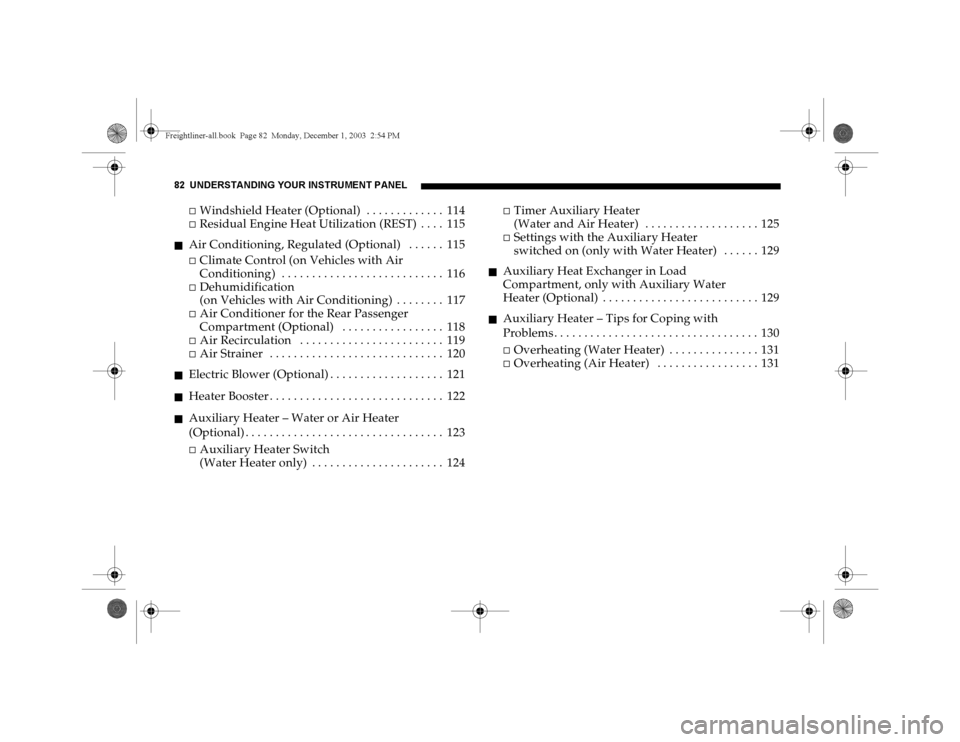
82 UNDERSTANDING YOUR INSTRUMENT PANEL
�Windshield Heater (Optional) . . . . . . . . . . . . . 114�Residual Engine Heat Utilization (REST) . . . . 115
�
Air Conditioning, Regulated (Optional) . . . . . . 115�Climate Control (on Vehicles with Air
Conditioning) . . . . . . . . . . . . . . . . . . . . . . . . . . . 116�Dehumidification
(on Vehicles with Air Conditioning) . . . . . . . . 117�Air Conditioner for the Rear Passenger
Compartment (Optional) . . . . . . . . . . . . . . . . . 118�Air Recirculation . . . . . . . . . . . . . . . . . . . . . . . . 119�Air Strainer . . . . . . . . . . . . . . . . . . . . . . . . . . . . . 120
�
Electric Blower (Optional) . . . . . . . . . . . . . . . . . . . 121
�
Heater Booster . . . . . . . . . . . . . . . . . . . . . . . . . . . . . 122
�
Auxiliary Heater – Water or Air Heater
(Optional) . . . . . . . . . . . . . . . . . . . . . . . . . . . . . . . . . 123�Auxiliary Heater Switch
(Water Heater only) . . . . . . . . . . . . . . . . . . . . . . 124
�Timer Auxiliary Heater
(Water and Air Heater) . . . . . . . . . . . . . . . . . . . 125�Settings with the Auxiliary Heater
switched on (only with Water Heater) . . . . . . 129
�
Auxiliary Heat Exchanger in Load
Compartment, only with Auxiliary Water
Heater (Optional) . . . . . . . . . . . . . . . . . . . . . . . . . . 129
�
Auxiliary Heater – Tips for Coping with
Problems . . . . . . . . . . . . . . . . . . . . . . . . . . . . . . . . . . 130�Overheating (Water Heater) . . . . . . . . . . . . . . . 131�Overheating (Air Heater) . . . . . . . . . . . . . . . . . 131
Freightliner-all.book Pag e 82 Monday , December 1, 2003 2:54 PM